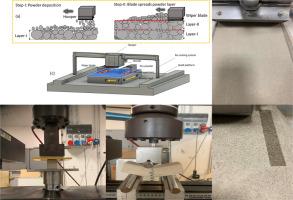水-速凝水泥比和骨料粒度对粘结剂喷射三维打印体的机械性能和尺寸精度的影响
IF 2.9
Q1 MATERIALS SCIENCE, CERAMICS
引用次数: 0
摘要
本研究采用粘结剂喷射三维打印(BJ3DP)技术生产水泥基速凝材料,旨在研究水灰比和骨料粒度等加工参数如何影响产品的最终性能。研究使用了市售的速凝水泥和硅砂。测量了不同加工条件下的尺寸精度、抗压强度和抗折强度,并分析了它们各自的影响。结果表明,印刷部件的性能受到所考虑的加工变量的显著影响,特别是较大的水灰比对机械性能有有利影响,当使用较粗的硅砂时,改善程度更高。研究还表明,使用较细的砂会导致尺寸精度更加有限。本文章由计算机程序翻译,如有差异,请以英文原文为准。

Effect of water-to-quick setting cement ratio and aggregate size on mechanical properties and dimensional accuracy of binder jetting 3D-printed bodies
Quick setting cement-based materials were produced in the present work using the binder jetting 3D printing (BJ3DP) technique with the aim at investigating how processing parameters like water-to-cement ratio and aggregate size affect the final properties of the products. Commercially available quick-setting cement and siliceous sand were utilized. Dimensional accuracy, compressive and flexural strength were measured for variable processing conditions and their individual effect was analysed. The results showed that the properties of printed parts are significantly influenced by the considered processing variables and, in particular, a larger water-to-cement ratio has a beneficial effect on the mechanical performances, the improvement being higher when coarser siliceous sand is used. It was also shown that the employment of finer sand results in more limited dimensional accuracy.
求助全文
通过发布文献求助,成功后即可免费获取论文全文。
去求助
来源期刊

Open Ceramics
Materials Science-Materials Chemistry
CiteScore
4.20
自引率
0.00%
发文量
102
审稿时长
67 days
 求助内容:
求助内容: 应助结果提醒方式:
应助结果提醒方式:


